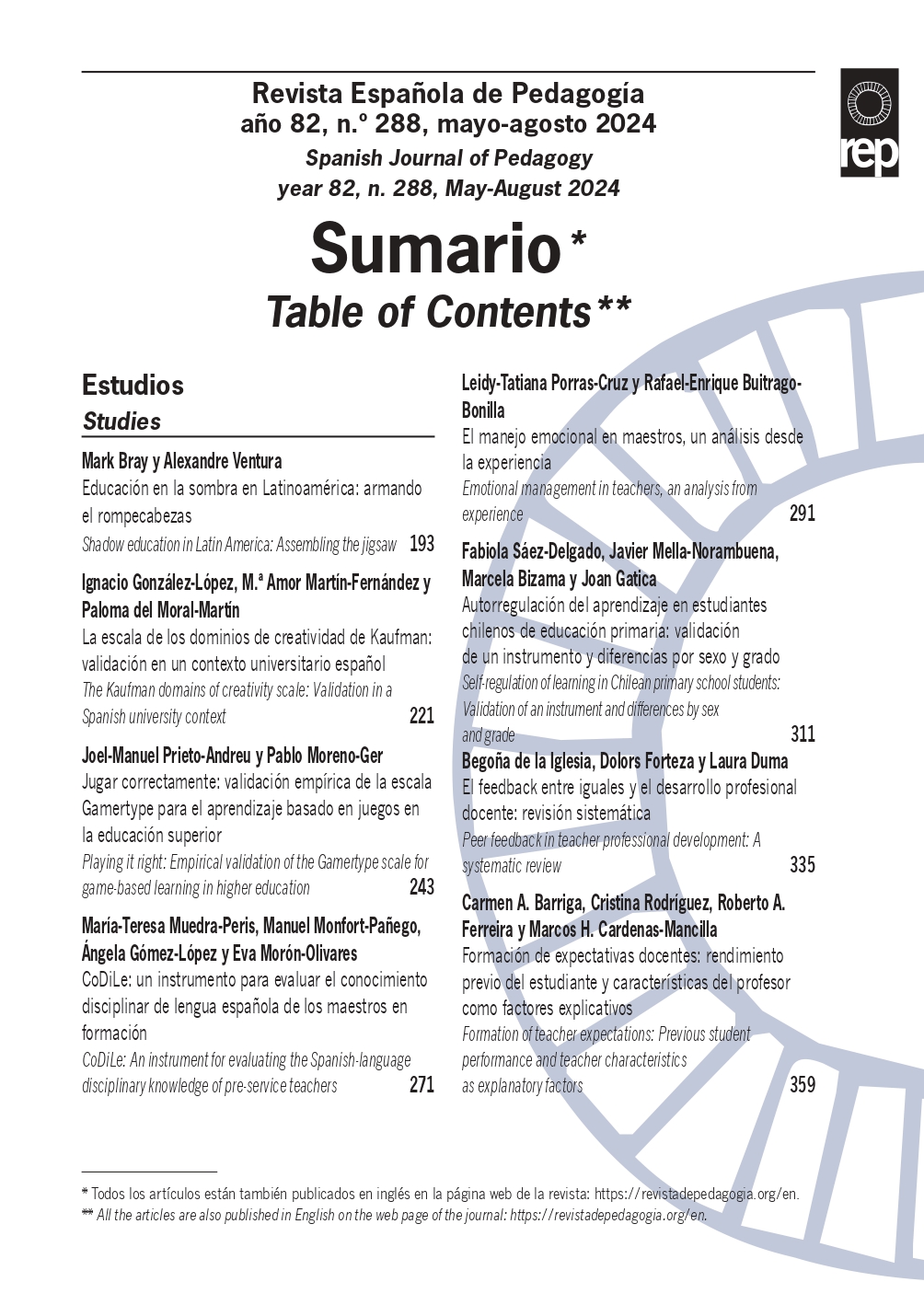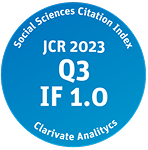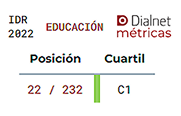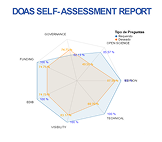Playing it right: Empirical validation of the Gamertype scale for game-based learning in higher education.
DOI:
https://doi.org/10.22550/2174-0909.4056Keywords:
scale, gamification, profile, player, validation, motivation, game-based learning, games, design, education, confirmatory analysis, exploratory analysis, factor analysisAbstract
The growing interest in applying gamified designs in higher education is challenged by mixed results in terms of student acceptance. Different players are attracted to games for different reasons and game design elements, and a better understanding of how each learner will connect to different game mechanics provides valuable input for game design and evaluation. In this paper, we present and validate a scale to measure the affinity of each player with different game elements. First, a theoretical review was carried out on three profile classifications and six motivational theoretical models, proposing a taxonomy for twelve player profiles based on three axes: relational, competence and motivational. Then, a pilot test was carried out with 54 subjects, analysing content and comprehension validity through the judgment of six experts and construct validity through an exploratory factorial analysis. Subsequently, with a sample of 1010 subjects, a confirmatory factor analysis was performed. The scale was made up of 30 items, with a Cronbach’s alpha of 0.822; three main components were obtained: dominators, interactors and trackers. The results show the validity of the scale, with high levels of confidence. It provides an understanding of the player’s profile in a playful context, their motivational orientation and their affinity with the specific game design. This can be used to improve the design of gamified experiences in higher education.
Downloads
References
Al-Azawi, R., Al-Faliti, F., y Al-Blushi, M. (2016). Educational gamification vs. game based learning: Comparative study [Gamificación educativa frente a aprendizaje basado en juegos: estudio comparative]. International Journal of Innovation, Management and Technology, 7 (4), 132- 136. https://doi.org/10.18178/ijimt.2016.7.4.659
Bartle, R. (1996). Hearts, clubs, diamonds, spades: Players who suit MUDs [Corazones, bastos, diamantes y espadas: jugadores afines a los MUD]. Journal of MUD Research, 1 (1), 19.
Bartle, R. (2005). Virtual worlds: Why people play [Mundos virtuales: ¿por qué juegan las personas?]. Massively Multiplayer Game Development, 2 (1), 3-18.
Chou, Y. K. (2014, 22 de septiembre). Octalysis: Complete gamification framework [Octalysis: un marco complete para la gamificación]. LinkedIn. https://www.linkedin.com/pulse/20140922202253-5757314-octalysiscomplete-gamification-framework/
Deci, E. L., y Ryan, R. M. (1985). Intrinsic motivation and self-determination in human behavior [Motivación intrínseca y autodeterminación en el comportamiento humano]. Springer. https://doi.org/10.1007/978-1-4899-2271-7
Espinoza, E. E., y Toscano, D. T. (2015). Metodología de investigación educativa y técnica [Educational research methodology and technique]. UTMach.
Ferro, L. S., Walz, S. P., y Greuter, S. (2013). Towards personalised, gamified systems: An investigation into game design, personality and player typologies [Hacia sistemas personalizados y gamificados: una investigación sobre el diseño de juegos, personalidad y tipologías de jugadores]. En Association for Computing Machinery (Ed.), IE 2013. Proceedings of the 9th Australasian Conference on Interactive Entertainment: Matters of Life and Death. AMC. https://doi.org/10.1145/2513002.2513024
Fullerton, T. (2008). Game design workshop. A playcentric approach to creating innovative games [Taller de diseño de juegos. Un enfoque centrado en el juego para crear juegos innovadores]. CRC Press. http://dx.doi.org/10.1201/b13172-10
Hamari, J., y Tuunanen, J. (2014). Player types: a meta-synthesis [Tipos de jugadores: una metasíntesis]. Transactions of the Digital Games Research Association, 1 (2), 29-53. http://dx.doi.org/10.26503/todigra.v1i2.13
Hu, L., y Bentler, P.M. (1999). Cutoff for fit indexes in covariance structure: Conventional versus new alternatives [Criterios de corte para índices de ajuste en análisis de estructura de covarianza: criterios convencionales versus nuevas alternativas]. Structural Equation Modeling: A Multidisciplinary Journal, 6 (1), 1-55. http://dx.doi.org/10.1080/10705519909540118
Huta, V., y Waterman, A. S. (2014). Eudaimonia and its distinction from hedonia: Developing a classification and terminology for understanding conceptual and operational definitions [Eudaimonía y su distinción de la hedonía: desarrollo de una clasificación y terminología para comprender definiciones conceptuales y operativas]. Journal of Happiness Studies, 15 (6), 1425-1456. http://dx.doi.org/10.1007/s10902-013-9485-0
Jia, Y., Xu, B., Karanam, Y., y Voida, S. (2016). Personality-targeted gamification: a survey study on personality traits and motivational affordances [Gamificación orientada a la personalidad: un estudio de encuesta sobre rasgos de personalidad y facilitadores motivacionales]. En Association for Computing Machinery (Ed.), Proceedings of the 2016 CHI Conference on Human Factors in Computing Systems (pp. 2001-2013). ACM. https://doi.org/10.1145/2858036.2858515
Johnson, D., Deterding, S., Kuhn, K.-A., Staneva, A., Stoyanov, S., y Hides, L. (2016). Gamification for health and wellbeing: A systematic review of the literature [Gamificación para la salud y el bienestar: una revisión sistemática de la literatura]. Internet Interventions, 6, 89-106. https://doi.org/10.1016/j.invent.2016.10.002
Kapp, K. M. (2012). The gamification of learning and instruction: Game-based methods and strategies for training and education [La gamificación del aprendizaje y de la instrucción: métodos basados en juegos y estrategias para la formación y la educación]. John Wiley & Sons.
Krath, J., Schürmann, L., y Von Korflesch, H. F. (2021). Revealing the theoretical basis of gamification: A systematic review and analysis of theory in research on gamification, serious games and game-based learning [Desvelando las bases teóricas de la gamificación: una revisión sistemática y análisis de la teoría en la investigación sobre gamificación, juegos serios y aprendizaje basado en juegos]. Computers in Human Behavior, 125, 106963. https://doi.org/10.1016/j.chb.2021.106963
Marczewski, A. (2015). Gamification: Even ninja monkeys like to play. Unicorn edition [Gamificación: incluso a los monos ninja les gusta jugar. Edición unicornio]. Gamified UK.
Martínez-Sanz, J. M., Urdampilleta, A., Guerrero, J., y Barrios, V. (2011). El somatotipo-morfología en los deportistas. ¿Cómo se calcula? ¿Cuáles son las referencias internacionales para comparar con nuestros deportistas? Lecturas: Educación Física y Deportes, 16 (159), 4. https://cutt.ly/YXpnpkz
Mora, A., Riera, D., González, C., y Arnedo-Moreno, J. (2017). Gamification: A systematic review of design frameworks [Gamificación: una revisión sistemática de los marcos de diseño]. Journal of Computing in Higher Education, 29 (3), 516-548. http://dx.doi.org/10.1007/s12528-017-9150-4
Nacke, L. E., Bateman, C., y Mandryk, R. L. (2013). BrainHex: A neurobiological gamer typology survey [BrainHex: una encuesta de tipología de jugadores desde una perspectiva neurobiológica]. Entertainment Computing, 5 (1), 55-62. https://doi.org/10.1016/j.entcom.2013.06.002
Prieto, J. M. (2022). Revisión sistemática sobre la evaluación de propuestas de gamificación en siete disciplinas educativas. Teoría de la Educación. Revista Interuniversitaria, 34 (1), 189- 214. https://doi.org/10.14201/teri.27153
Ryan, R. M., y Deci, E. L., y Vansteenkiste, M. (2016). Autonomy and autonomy disturbances in self-development and psychopathology: Research on motivation, attachment, and clinical process [Autonomía y perturbaciones en la autonomía en el auto-desarrollo y la psicopatología: Investigación sobre motivación, apego y proceso clínico]. En D. Cicchetti (Ed.), Developmental psychopathology: Theory and method [Psicopatología del desarrollo: teoría y método] (pp. 385-438). John Wiley & Sons. https://doi.org/10.1002/9781119125556.devpsy109
Ryan, R., y Deci, E. L. (2000). Self-determination theory and the facilitation of intrinsic motivation, social development, and well-being [La teoría de la autodeterminación y la facilitación de la motivación intrínseca, el desarrollo social, y el bienestar]. American Psychologist, 55 (1), 68- 78. https://doi.org/10.1037/0003-066X.55.1.68
Schuurman, D., De Moor, K., De Marez, L., y Van Looy, J. (2008). Fanboys, competers, escapists and time-killers: A typology based on gamers’ motivations for playing video games [Fanboys, competidores, escapistas y pasatiempos: una tipología basada en las motivaciones de los jugadores de videojuegos]. En Association for Computing Machinery (Ed.), Proceedings of the 3rd International Conference on Digital Interactive Media in Entertainment and Arts (pp. 46-50). ACM. https://doi.org/10.1145/1413634.1413647
Sezgin, S. (2020). Digital player typologies in gamification and game-based learning approaches: A meta-synthesis [Tipologías de jugadores digitales en enfoques de gamificación y aprendizaje basado en juegos: una metasíntesis]. Bartın University Journal of Faculty of Education, 9 (1), 49-68. https://doi.org/10.14686/buefad.610524
Tondello, G. F., Wehbe, R. R., Diamond, L., Busch, M., Marczewski, A., y Nacke, L. E. (2016). The gamification user types Hexad scale [La escala Hexad de tipos de usuarios de gamificación]. En Association for Computing Machinery (Ed.), Proceedings of the 2016 Annual Symposium On Computer-Human Interaction in Play (pp. 229-243). ACM. http://dx.doi.org/10.1145/2967934.2968082
Tondello, G. F., Mora, A., Marczewski, A., y Nacke, L. E. (2019). Empirical validation of the gamification user types Hexad scale in English and Spanish [Validación empírica de la escala Hexad de tipos de usuarios de gamificación en inglés y español]. International Journal of Human-Computer Studies, 127, 95-111. https://doi.org/10.1016/j.ijhcs.2018.10.002
Vahlo, J., Kaakinen, J. K., Holm, S. K., y Koponen, A. (2017). Digital game dynamics preferences and player types [Preferencias de dinámicas de juegos digitales y tipos de jugadores]. Journal of Computer-Mediated Communication, 22 (2), 88-103. https://doi.org/10.1111/jcc4.12181
Valderrama, B. (2018). La rueda de motivos: hacia una tabla periódica de la motivación humana. Papeles del Psicólogo, 39 (1), 60-70. https://doi.org/10.23923/pap.psicol2018.2855
Yee, N. (2015). Gamer motivation model: Overview and descriptions [Visión general y descripciones del modelo de motivación del jugador]. Quantic Foundry. http://quanticfoundry.com/2015/12/15/handy-reference
Yee, N., Ducheneaut, N., y Nelson, L. (2012). Online gaming motivations scale: Development and validation [Escala de motivaciones para juegos en línea: desarrollo y validación]. In Association for Computing Machinery (Ed.), Proceedings of the SIGCHI Conference on Human Factors in Computing Systems (pp. 2803-2806). ACM. https://doi.org/10.1145/2207676.2208681
Zahedi, L., Batten, J., Ross, M., Potvin, G., Damas, S., Clarke, P., y Davis, D. (2021). Gamification in education: A mixed-methods study of gender on computer science students’ academic performance and identity development [Gamificación en la educación: Un estudio de métodos mixtos sobre el género en el rendimiento académico y desarrollo de identidad de estudiantes de ciencias de la computación]. Journal of Computing in Higher Education, 33 (2), 441-474. https://doi.org/10.1007/s12528-021-09271-5
Downloads
Published
-
Abstract76
-
PDF (Español)49
-
PDF49
How to Cite
Issue
Section
License

This work is licensed under a Creative Commons Attribution-NonCommercial 4.0 International License.










